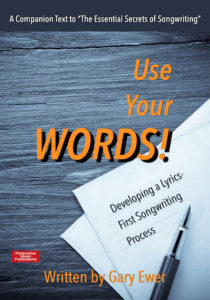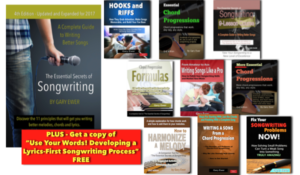When we think of the term musical energy, we might immediately think of loudness and tempo. But as a songwriter, you need to develop a slightly more sophisticated understanding of how musical energy works, and what it can do to make people want to listen to — and come back to — your songs.
 If you’re trying to make your lyrics a much more important part of your songs, you need to read “Use Your Words! Developing a Lyrics-First Songwriting Process.” It’s part of “The Essential Secrets of Songwriting 10-eBook Bundle”, and right now, it’s FREE.
If you’re trying to make your lyrics a much more important part of your songs, you need to read “Use Your Words! Developing a Lyrics-First Songwriting Process.” It’s part of “The Essential Secrets of Songwriting 10-eBook Bundle”, and right now, it’s FREE.
Musical energy (or “song energy”) is a relative term. It needs to be present in all music, whether that song is a very quiet ballad, or a loud, raucous rock song. Another way to look at musical energy is to think of it as what makes us want to keep listening.
Musical energy does get generated by loudness and by quicker tempos, that’s true. But there are other aspects of music that contribute to overall energy:
- The fullness (or “thickness”) of the sounds you use.
- Your choice of instruments.
- Rhythmic activity.
- Emotional quality of the lyrics.
- The quality of sound of the lead vocal.
- Vocal range.
Depending on your genre of choice, those aspects will be realized in different ways, but the most important thing you need to know as a songwriter is this: musical energy needs to rise and fall throughout a song.
Some aspects won’t change at all as a song progresses. For example, it’s common for the tempo you start with to be the tempo you end with. And some songs might even keep a fairly constant volume throughout.
But even though some elements stay the same, others need to grow and diminish. For quiet songs, that up and down of musical energy will be very slight; not much change is needed to be noticeable, and that’s where energy as a relative quality becomes obvious.
If you find that you (or your audience) lose interest in your song as it moves from start to finish, think about its musical energy. What aspects of your song contribute to its basic energy level, and what have you done to increase and then decrease energy?
It’s often in the lyrics where songwriters miss opportunities to build and then diminish energy. Sometimes, lyrics will be full-on emotion, and that just ends up dulling the senses of the listener. Be sure that lyrics move from unemotional to emotional, and back again throughout the song.
Think about the production choices you’ve made as well. Find moments to bring everything down a bit before building it up again. That creates a strong sense of expectancy in the music, and audiences react very positively to that, even though it usually works subconsciously.
So to summarize, keep the musical energy of your song moving up and down as it proceeds. You’ll find that during quieter or less emotional moments, audiences are expecting things to build again, and they love the effect.
A song like “Bridge Over Troubled Water” is a great example. It builds energy in an upward direction, but on closer inspection you’ll notice that that upward build of energy is not a straight line. There are moments where it becomes more intense, and then other moments where it briefly relaxes.
In that regard, “Bridge Over Troubled Water” provides the best model for songwriters to follow.
 Written by Gary Ewer. Follow Gary on Twitter.
Written by Gary Ewer. Follow Gary on Twitter.
 “The Essential Secrets of Songwriting” eBook bundle includes“Writing a Song From a Chord Progression”. Discover the secrets of making the chords-first songwriting process work for you.
“The Essential Secrets of Songwriting” eBook bundle includes“Writing a Song From a Chord Progression”. Discover the secrets of making the chords-first songwriting process work for you.










